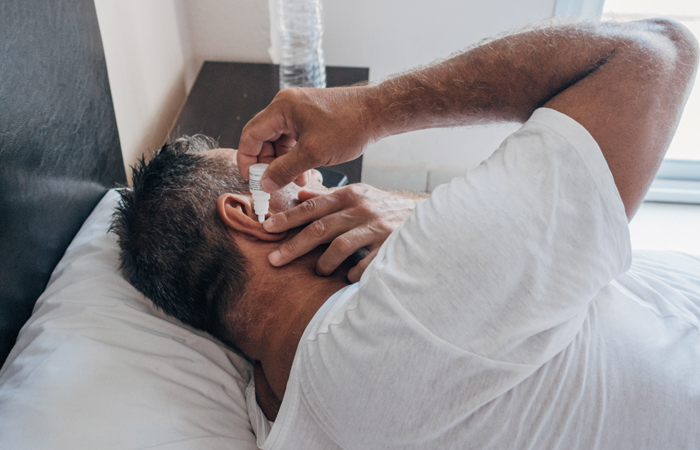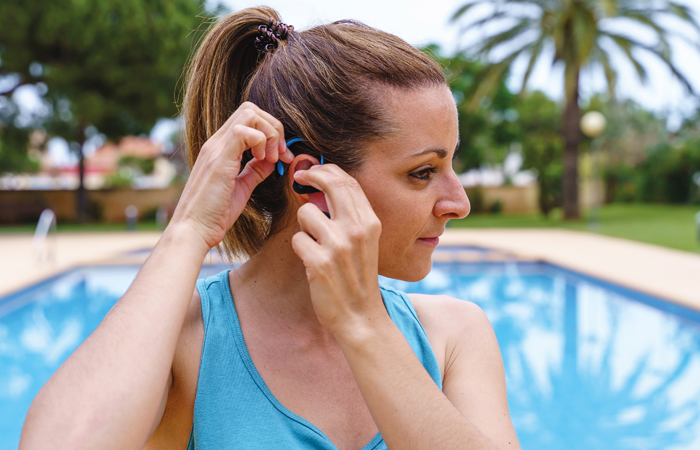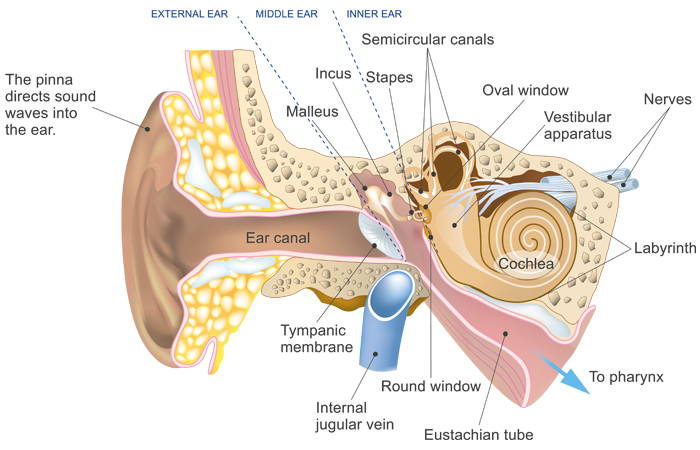In Conditions
Bookmark
Record learning outcomes
Currently one in six people in the UK are affected by hearing loss, with around 900,000 being classed as clinically deaf.
In fact, there are more people living in the UK with hearing loss than diabetes, coronary heart disease and cancer combined, according to hearing clinic, Hear4U. Hearing loss, however, is not the only way ears can be affected. Many people experience issues with their ears from time to time – from a build-up of earwax to tinnitus or infections. Most ear problems clear up quickly with the right treatment and are unlikely to lead to any long-term problems. However, they can cause a lot of discomfort, affect hearing and – if they involve the inner ear – cause vertigo so customers will need to deal with any symptoms quickly and effectively.
Community pharmacy is often the first port of call for ear health advice, so it’s vital that the whole pharmacy team knows how to help. While some acute symptoms, such as sudden or severe hearing loss, require a GP appointment, others may be treated over-the-counter.
Earwax build-up
Although earwax (cerumen) serves to keep the outer ear clean and protects it from damage, it sometimes builds up and blocks the ear canal. This can occur at any age but is most likely to affect older people and those wearing hearing aids or using earbud earphones. In November 2022, many people reported symptoms that can be associated with earwax blockage, such as hearing loss, tinnitus, earache and dizziness, according to the Royal National Institute for Deaf People (RNID). Some also reported that these symptoms affect their overall wellbeing, including their mental health.
“General advice says to leave earwax alone,” explains Nic Wray, communications manager at Tinnitus UK. “However, earwax build-up can affect how well hearing aids work, and for some people can trigger tinnitus. If earwax build up is bothersome, it should be treated. Cotton buds or other items shouldn’t be inserted into the ears, but earwax-softening drops or olive oil should be considered as the first option.”
Medical grade olive oil ear drops can be used three to four time a day for three to five days to reduce earwax build-up as well as earwax removing drops or sprays. These soften the impacted wax so that it then falls out naturally.
Self-management isn’t always sufficient on its own, however, and people with hearing loss, earache, tinnitus, itchy ears or vertigo may need to have their earwax removed. “While in many cases, earwax can be safely and effectively removed at home using over-the-counter ear drops or by gently flushing the ear with warm water, in some instances it’s best to call in the professional,” says Rob Ormerod, audiology director at Bayfields Opticians and Audiologists. “There are a number of techniques your healthcare professional will use, including micro-suction for the safest wax removal.”
About 2.3 million people each year in the UK have troublesome earwax requiring removal, according to research published in January 2023 by University of Manchester audiologists in the British Journal of General Practice. The researchers found that hearing difficulty was the most common and troubling symptom of blocked ears – after the earwax had been removed, more than eight out of 10 people noticed an immediate improvement.
“One in six people in the UK are affected by hearing loss, with around 900,000 being classed as clinically deaf.”
Outer ear infections
Otitis externa causes inflammation and infections of the outer ear canal. This can trigger ear pain, a watery discharge and temporary hearing loss. Otitis externa may be caused by a bacterial or fungal infection, a skin condition such as eczema or psoriasis, or an allergy (e.g., to hair products). It may also be triggered by swimming, sweating or being in a humid environment. Using cotton buds to dry or clean out the inside of the ear, or scratching inside the ear, increases the risk.
Acidic eardrops are available over-the-counter from pharmacies. These will help to stop any bacterial or fungal infection from spreading. If the symptoms persist, customers should contact their GP who may prescribe stronger medicated ear drops (often containing a corticosteroid), or antibiotics for a severe infection. To prevent swimmer’s ear, customers should be advised to wear earplugs designed for swimming and bathing to stop water getting into the ears. With treatment, otitis externa should clear up within two or three days.
Middle ear infections
Otitis media (an infection in the middle part of the ear) is most common in young children but can affect all age groups. It generally occurs when a bacterial or viral infection spreads from the nose or throat into the ear. The infection leads to a build-up of fluid inside the ear, which can lead to earache and slight hearing loss. In severe cases, the eardrum can tear, with a sudden discharge of pus and blood into the outer ear canal.
Most middle ear infections clear up within a few days to a week without any specific treatment. Taking painkillers, such as paracetamol or ibuprofen, and placing a cold or warm flannel against the ear may help to ease any pain. If there’s no improvement after three days, or the patient is very ill, a GP may prescribe eardrops containing a painkiller and anaesthetic. Antibiotics aren’t usually needed for a middle ear infection, but these may be prescribed if the symptoms are severe.
Glue ear
Usually, excess fluid inside the middle ear drains away down the narrow Eustachian tube, which runs from the middle ear to the back of the throat. But sometimes sticky fluid builds up, leading to glue ear. Glue ear may develop after a middle ear infection. Other possible causes include colds and flu, allergies and passive smoking.
Glue ear generally causes temporary hearing loss, affecting one or both ears, along with earache or tinnitus. It may also affect balance. In children, possible signs of glue ear include speaking more loudly or quietly than usual, seeming tired and irritable, and asking for the TV or music to be turned up. If glue ear lasts for a long time, it can affect a child’s speech development and progress at school.
A GP can diagnose glue ear by looking for fluid inside the ear. They may decide not to treat it, as glue ear usually clears up on its own after around three months. However, antibiotics may be prescribed if the glue ear is causing infections.
While waiting for the glue ear to clear up naturally, a GP may suggest trying a treatment called auto inflation, which helps the fluid to drain away. Auto inflation involves either blowing up a special balloon using one nostril at a time or swallowing while holding the nostrils closed. This needs to be performed several times a day so it’s not usually recommended for children under three years.
If the glue ear doesn’t improve, a GP may refer a patient to an ears, nose and throat (ENT) surgeon, who may suggest inserting tiny ventilation tubes (grommets) temporarily into the eardrum. This enables air to circulate so that the fluid can drain away.
Tinnitus
According to the RNID, around one in seven UK adults has tinnitus. Some people experience tinnitus if they have a build-up of earwax or fluid in their ears. It’s often a temporary problem that clears up once the earwax or fluid is removed.
“We recently conducted research which reveals that over 37.1 million people in the UK (55 per cent) have experienced constant noise in the ears, such as ringing, roaring, buzzing, hissing, whistling or humming – which is most common symptom of tinnitus,” says Rob. “Tinnitus is described as any noise you can hear that’s not in the environment, and it’s different for everybody. While some sufferers may experience a ringing, others may hear a static or whooshing sound, buzzing or in some instances even music.”
Prolonged exposure to loud sounds is the most common cause of tinnitus – accounting for up to 90 per cent of cases. “Simply turning down the volume on everyday activities can have a very real impact on our ear health,” explains Rob. “Limit the length of time you’re exposed to loud sounds and invest in hearing protection devices such as ear plugs and ear defenders and keep on your person.”
Nic says that it’s important to reassure people that tinnitus is common and may resolve by itself. “There are no medications or supplements proven to be effective for tinnitus, and people should be discouraged from taking them,” they say. “Although serious underlying conditions are rare, it’s important to signpost a person experiencing tinnitus to their GP for assessment, ear examination and referral into ENT/Audiology services. The team at Tinnitus UK can provide information and support.”
Anatomy of the ear
The ears contain three main parts – outer, middle and inner.
The outer ear consists of the pinna (the part you can see), the narrow ear canal and the eardrum. It’s made from bone and cartilage. The curved ear canal is about 2.5cm long. Inside, the first two-thirds is covered with tiny, thin hairs, and the inner third leading to the eardrum is smooth and contains glands that secrete earwax. The eardrum separates the ear canal from the middle ear – it’s like a tightly stretched skin of a drum and is easily damaged. When sound waves reach the eardrum, they cause it to vibrate.
The middle ear, behind the eardrum, is an air-filled space that leads to the back of the nose via the narrow Eustachian tube. It helps to maintain the correct pressure in the ears. Inside the middle ear, there are three tiny, interconnected bones called ossicles – the hammer (malleus), anvil (incus) and stirrup (stapes). These are the smallest bones in the body. The ossicles vibrate when there is a change in external pressure due to sound. The Eustachian tube lets air in and out of the middle ear but can also spread infections from the nose and throat to the ears.
The inner ear contains the cochlea, which is the snail-shaped organ of hearing, and the vestibular labyrinth (which controls balance). The cochlea is around the size of a little fingernail. It is filled with fluid and houses thousands of specialist hair cells that are sensitive to sound. When the eardrum and ossicles vibrate, this stimulates these hair cells, and the fluid inside the cochlear moves like a wave. Each hair cell is a different length and responds most to a particular pitch of sound. When stimulated, the hairs send a signal to the hearing centre of the brain through the vestibulocochlear nerve. The brain transforms the sound waves into electrical signals, and you then hear the sound that made the pressure change.
“Otitis media is most common in young children but can affect all age groups”
Pharmacy accessibility
One in five adults in the UK are deaf, have hearing loss or tinnitus, and an estimated 1.2 million adults in the UK have hearing loss severe enough that they wouldn’t be able to hear most conversational speech.
In May 2023, research by the Royal National Institute for Deaf People (RNID) found that 59 per cent of people wouldn’t feel confident communicating with someone who is deaf or has hearing loss, and one in 10 even said they would actively avoid communicating with someone who is deaf or has hearing loss.
There are many ways to make a pharmacy more accessible. “Think about how customers can contact you,” says Teri Devine, director for inclusion and employment at RNID. “Make sure you have an email or text option listed on your website as well as phone and include options for people to contact you through Relay UK or video relay services for British Sign Language (BSL) users. You should also consider giving your staff basic deaf awareness training or BSL training, and make sure that you have a hearing loop for customers with hearing aids, and that it is switched on and serviced regularly.”
The RNID shares communication tips in the ‘information and support’ section of its website and also suggests that people use the EAR approach to help make communication easier.
- Environment – reduce background noise or move to a quieter area, and make sure the room is well lit if the person relies on lipreading
- Attention – use simple gestures such as pointing, waving or a light tap on the shoulder to get someone’s attention. Face the person you’re speaking to so they can lipread, and speak to them, not their interpreter or anyone else with them
- Repeat and rephrase – if someone doesn’t understand you, try repeating what you said or rephrasing it in a different way. If this doesn’t work, you could write it down, or speak to a friend or relative if they ask you to.





